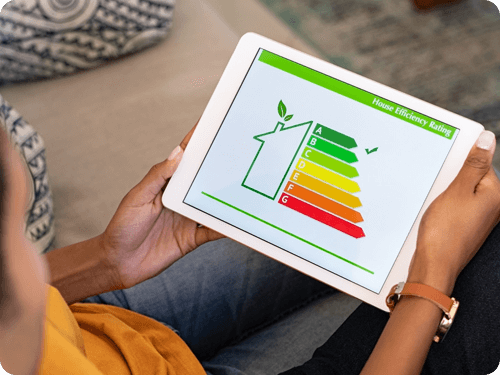Understanding SEER Ratings and How They Relate to Energy Efficiency

Energy efficiency is an important factor to consider when buying any new HVAC equipment, whether it be a central AC unit, a furnace, a heat pump, or even a window air conditioner. All HVAC equipment is rated in terms of energy efficiency to allow you to compare how much energy different models will use. The higher the efficiency rating, the less energy the unit will use to run and the more you’ll save on your heating and cooling costs.
Air conditioners, ductless mini-splits, heat pumps, and most other cooling equipment are rated for energy efficiency based on their seasonal energy efficiency ratio, or SEER. All manufacturers, equipment dealers, and retailers are required to display the equipment’s SEER number so that you know how efficient it is. Nonetheless, these SEER values can be confusing if you don’t know what they mean.
What Is the SEER Rating System?
Just like the fuel efficiency of furnaces is expressed in terms of AFUE (annual fuel utilization efficiency), the efficiency of all cooling equipment is measured in terms of SEER. With furnaces, measuring the efficiency is as simple as determining what percentage of energy — gas or electricity — that it converts into heat. As long as the furnace is functioning properly, this number shouldn’t ever change. However, measuring the efficiency of an air conditioner or other type of cooling equipment isn’t nearly as easy.
The fact that the cooling equipment sits outside your house means it is directly affected by the outdoor temperatures. This makes it much more difficult to precisely measure its efficiency since it can go up and down based on temperature fluctuations and how humid or how dry the air is. As a result, the only real way to accurately judge the efficiency of cooling equipment is to measure how much energy it uses during the course of the entire cooling season.
When calculating SEER, the equipment is set to a desired indoor temperature, which is the temperature at which you would generally have your thermometer set. It is then subjected to temperatures ranging from 60 to 100 degrees Fahrenheit in order to simulate the typical conditions it might experience over the course of the summer. This provides a baseline of approximately how much energy the unit would use throughout the entire cooling season.
Nonetheless, the amount of energy the unit uses is in large part based on its size and how much cooling it produces. As a result, total energy usage is only half of the equation. To calculate SEER, you have to take the amount of cooling that the unit produces measured in terms of BTUs and divide this number by the total watt-hours of electricity used during the entire cooling season.
Based on this calculation, the unit is assigned a SEER rating that shows how efficient it is. Unlike AFUE percentages for furnaces, the SEER values don’t mean anything on their own. Instead, SEER is simply a scale that allows you to compare the efficiency of different models.
This is important to understand since, unlike furnaces, the efficiency of an air conditioner can fluctuate quite a lot based on the outdoor temperature and humidity level. It is often helpful to think of SEER in a similar way as you would the fuel efficiency ratings for a car. If the fuel efficiency of a car is 40 miles per gallon, this means that is the maximum efficiency it can achieve under normal circumstances. Similarly, SEER shows the maximum average efficiency an air conditioner will achieve in typical conditions over the entire course of one cooling season.
SEER Ratings and Minimum Efficiency Standards
The U.S. Department of Energy sets minimum efficiency standards for all HVAC equipment. These minimums were originally introduced as part of the National Appliance Energy Conservation Act of 1987 and, as you might expect, have changed quite a lot since then. The most recent changes were introduced in 2015, and they are set to change again in 2023.
As of 2015, all air conditioners installed in Alabama, Mississippi, and the rest of the southern U.S. must be at least 14 SEER. For northern states, the minimum is 13 SEER. From 2023, the minimum will rise to 15 SEER for all southern states and 14 SEER for the northern part of the country.
If you are considering replacing your air conditioner, it is definitely best to do it before 2023. If you wait, you’ll probably end up paying more for your new unit since it will have to meet the higher minimum efficiency standards.
There are also minimum efficiency requirements for all heat pumps and mini-split systems, and these are the same throughout the entire United States. For mini-split air conditioners, the minimum is 15 SEER whereas all heat pumps must be at least 14 SEER. Heat pumps also have minimum requirements for heating efficiency since they produce both heating and cooling. Still, that is a whole different rating system that requires its own thorough explanation.
Calculating Energy Savings Using SEER Ratings
The Department of Energy has produced handy charts that allow you to see approximately how much energy you can save by comparing the minimum 13 SEER to higher-rated units. There are also numerous calculators online that enable you to calculate the energy savings based on the SEER of your existing air conditioner. This makes it much easier to determine whether the increased energy savings of a more efficient unit are worth the additional money the higher SEER unit costs.
Residential air conditioners usually range between 14 and 22 SEER. Still, there are some highly efficient models that go as high as 25 or 26 SEER. For highly efficient mini-split AC systems, the SEER could be well over 30.
Choosing a 16 SEER unit instead of the minimum 14 SEER should result in around 13% less energy use. On the other hand, a 25 SEER could cut your cooling costs almost in half compared to a 14 SEER. However, a 25 SEER unit is also likely to cost several thousand dollars more. For this reason, the choice will usually come down to how much you are willing to spend for improved efficiency.
Even if 14 SEER is the bare minimum required by law in Alabama and other southern states, this doesn’t automatically mean that a 14 SEER AC is bad. Replacing your old AC will almost always reduce your energy costs. This is especially the case if your current AC was installed prior to 2006 when the minimum was only 10 SEER. You could reduce your energy usage further by upgrading to a higher SEER unit, but even upgrading from 10 to 14 SEER can still result in energy savings of nearly 30%.
Professional AC Installation and More
If you’re searching for AC or heat pump installation services, look no further than the experts at Hansen Super Techs. We specialize in residential and commercial central AC and heating installation, repair, and maintenance services, as well as ductless mini-split systems. Our team can handle any of your indoor air quality needs as well. We also offer a range of plumbing and electrical services.
Our primary location is in Theodore, AL, but we also have several other locations throughout southeastern Alabama and southwestern Mississippi. For more information about AC installation or our other services, give the team at Hansen Super Techs a call today.


